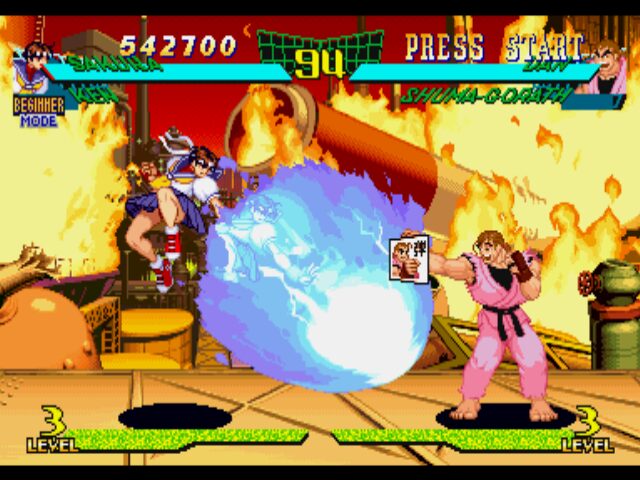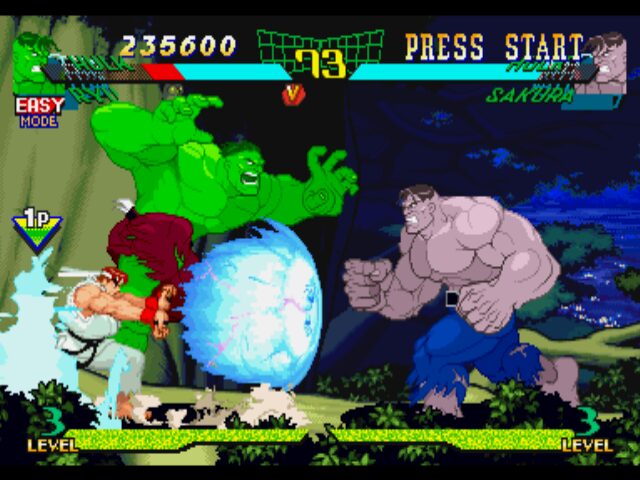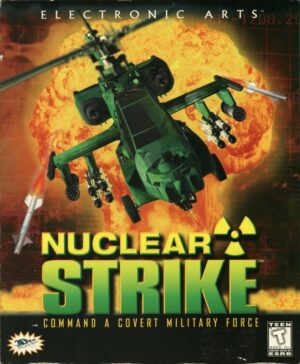Retro Replay Review
Gameplay
Marvel Super Heroes vs. Street Fighter revolutionizes the 2D fighting genre by introducing a tag-team system that lets you switch between two characters on the fly. During a match, you control one fighter at a time while your partner recovers a small portion of health off-screen. You can call in your teammate at almost any moment—either to continue normal combo pressure or to execute powerful Variable Attacks, Variable Counters, and Variable Combinations that leverage both characters’ special moves in tandem.
This tag mechanic adds a deep layer of strategy, as you must decide when to tag out to refill health, which partner to send in to counter your opponent’s momentum, and how best to chain teamwork specials for maximum damage. Timing is critical: tagging in mid-move can catch your rival off guard, but mistiming it may leave you vulnerable. The game’s pacing remains brisk, balancing fast-paced Street Fighter inputs with Marvel’s signature over-the-top super attacks.
Matches end only when both of your chosen characters have been defeated, so endurance and resource management are as important as raw combo execution. While the arcade and Saturn versions fully embrace the tag feature, the PlayStation port strips it out in favor of a more traditional best-two-out-of-three rounds format. This change alters the dynamics significantly, making the console experience feel more like a straightforward Street Fighter clone than the groundbreaking tag-team brawler it was in arcades.
Graphics
Visually, Marvel Super Heroes vs. Street Fighter stands out with bold, colorful spritework that captures the essence of both universes. Capcom’s artists improved upon their earlier work in X-Men: Children of the Atom and Marvel Super Heroes, delivering larger-than-life character portraits and smooth animation frames. Each fighter has a distinct pixel art style, from the flowing capes of Gambit and Rogue to the rugged physiques of Zangief and Juggernaut.
The backgrounds are richly detailed, showcasing iconic locales like the streets of Metro City, the Sanctum Sanctorum, and the Savage Land. Animated environmental elements—blazing fires, flickering neon signs, and tumultuous weather effects—add depth and atmosphere to every stage. These backdrops not only look vibrant but also contribute to the game’s overall energy, making each battle feel like a set piece lifted straight from the comics or the Street Fighter saga.
Special moves come alive with dynamic flash effects and multi-layered parallax. The Variable Combinations, in particular, feature lengthy, eye-catching sequences that underscore the power of teamwork. On more limited hardware like the PlayStation, some frames are trimmed, and the tag-team animations are omitted entirely, but the core visuals remain impressive even when pared down.
Story
While Marvel Super Heroes vs. Street Fighter is primarily a fighter with minimal narrative, it still offers a fun crossover premise: the sinister Apocalypse has called upon villains and heroes from both realms to prove his supremacy. Each character’s ending sequence provides a small vignette tying them back to their original universe—be it a heroic triumph, a cunning escape, or a sinister plot twist.
The roster blends familiar X-Men faces—Cyclops, Storm, Wolverine, and fan favorites like Rogue, Gambit, and Sabretooth—with Street Fighter stalwarts such as Ryu, Ken, Chun-Li (or Cammy on certain versions), Charlie, Dhalsim, Zangief, M. Bison, and hidden boss Akuma. This assortment allows for dream matchups—ever wondered who would win between Magneto’s magnetic might and Ryu’s Hadouken? The game lets you explore those fantasies, even if it doesn’t weave a deep, overarching plot.
Boss fights against Apocalypse serve as the narrative climax, pitting you against one of the most formidable antagonists in the Marvel universe. These encounters emphasize the game’s arcade roots: high difficulty spikes, flashy solo move sets, and a grand finale that rewards perseverance more than storytelling depth. Still, for fans of comic lore and fighting games alike, the novelty of seeing these characters interact carries its own appeal.
Overall Experience
Marvel Super Heroes vs. Street Fighter remains a standout entry in Capcom’s fighting game legacy. Its core tag-team mechanic breathes fresh life into the established 2D formula, rewarding both casual button-mashers and dedicated combo enthusiasts. Versus mode with a friend is especially electrifying—coordinating tag combos and trading high-octane special moves never gets old.
While the PlayStation version loses some of the arcade’s strategic depth by removing the tag feature, it still offers solid one-on-one fights and a respectable roster. The arcade and Saturn editions, however, represent the definitive experience; they showcase the full breadth of Capcom’s design innovations at the time. Online re-releases and modern compilations often emulate these versions, ensuring accessibility for new audiences.
For potential buyers, the game’s appeal lies in its unique crossover charm, tight controls, and replay value. Whether you’re a Marvel die-hard, a Street Fighter veteran, or someone seeking a thrilling two-on-two fighter, Marvel Super Heroes vs. Street Fighter delivers a nostalgic yet enduring blend of comic book spectacle and arcade precision. It’s a must-play classic that paved the way for future tag-team showdowns in the genre.
 Retro Replay Retro Replay gaming reviews, news, emulation, geek stuff and more!
Retro Replay Retro Replay gaming reviews, news, emulation, geek stuff and more!









Reviews
There are no reviews yet.